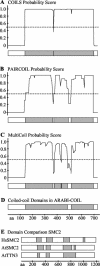Genome-wide identification of Arabidopsis coiled-coil proteins and establishment of the ARABI-COIL database
- PMID: 15020757
- PMCID: PMC389916
- DOI: 10.1104/pp.103.035626
Genome-wide identification of Arabidopsis coiled-coil proteins and establishment of the ARABI-COIL database
Abstract
Increasing evidence demonstrates the importance of long coiled-coil proteins for the spatial organization of cellular processes. Although several protein classes with long coiled-coil domains have been studied in animals and yeast, our knowledge about plant long coiled-coil proteins is very limited. The repeat nature of the coiled-coil sequence motif often prevents the simple identification of homologs of animal coiled-coil proteins by generic sequence similarity searches. As a consequence, counterparts of many animal proteins with long coiled-coil domains, like lamins, golgins, or microtubule organization center components, have not been identified yet in plants. Here, all Arabidopsis proteins predicted to contain long stretches of coiled-coil domains were identified by applying the algorithm MultiCoil to a genome-wide screen. A searchable protein database, ARABI-COIL (http://www.coiled-coil.org/arabidopsis), was established that integrates information on number, size, and position of predicted coiled-coil domains with subcellular localization signals, transmembrane domains, and available functional annotations. ARABI-COIL serves as a tool to sort and browse Arabidopsis long coiled-coil proteins to facilitate the identification and selection of candidate proteins of potential interest for specific research areas. Using the database, candidate proteins were identified for Arabidopsis membrane-bound, nuclear, and organellar long coiled-coil proteins.
Figures







References
-
- Barr FA, Short B (2003) Golgins in the structure and dynamics of the golgi apparatus. Curr Opin Cell Biol 15: 405-413 - PubMed
-
- Bascom RA, Srinivasan S, Nussbaum RL (1999) Identification and characterization of golgin-84, a novel golgi integral membrane protein with a cytoplasmic coiled-coil domain. J Biol Chem 274: 2953-2962 - PubMed
-
- Berger B, Singh M (1997) An iterative method for improved protein structural motif recognition. J Comput Biol 4: 261-273 - PubMed
-
- Burkhard P, Stetefeld J, Strelkov SV (2001) Coiled coils: a highly versatile protein folding motif. Trends Cell Biol 11: 82-88 - PubMed
Publication types
MeSH terms
Substances
LinkOut - more resources
Full Text Sources
Molecular Biology Databases
Research Materials

